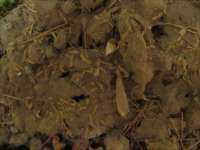An artwork for a better understanding of the necessity of Arab-Israeli peace.
This artwork is based on the metonymic nature of the hebrew word eretz meaning land, soil and ground. Land that is for israelites to take back with bloody wars against other men for the soil that brings life and wealth and in the ground that buries men, curdles and caresses them in the end. I am trying to expose the word eretz by its imaginary signifier to hold the metonymy and let my audience interpret the sense of the word free of determinations that are to be found in language itself. This might finally produce the experience peaceful eretz and may hold the word against the war for taking the land back.1 The body of work consists of four variable sized large light-boxes surrounding the exhibition space. Light-boxes will exhibit a detailed close up image of soil-ground. There has to be no lights in the room with the exception of the light-boxes so the general luminosity of the space is created by the bounced light of those images. Presumably the light will be colored within the various shades of orange, yellow and light brown. The soils may be of different types or they may be the repetition of the same soil sample but they have to be different photographs. After entering the space one finds out about different specifications and details in the photographs; places where one can relate itself to the images. He tends to discover the original size of the sample shown in the light-box. He recognizes the stones, fractures, plant life and human interference in the pictures and finally acknowledges the image through the relation of its primary nature(the soil sample), its hyperreality(what has been exposed from its primary nature and himself. During this relatively time-consuming task he subtly undergoes the effects of warm and dim light. As a basic notion of interior aesthetics the space reproduces comfort and security. Comfort being the property of dim light and security being the resemblance of any warm dim light to mens ancient days beside fire or experiences alike. After viewing the images one begins to interact within the space and under the influence of dim warm light. This second phase excludes/negates the pictorial role of the images as specifics and investigates the entirety of the images effect on the space and takes the audience as the object of this second life cycle. ERETZ-KIARASH ALIMI-2012 1 This eretz has similar lingual position in many different other languages.
An artwork for a better understanding of the necessity of Arab-Israeli peace.
This artwork is based on the metonymic nature of the hebrew word eretz meaning land, soil and ground. Land that is for israelites to take back with bloody wars against other men for the soil that brings life and wealth and in the ground that buries men, curdles and caresses them in the end. I am trying to expose the word eretz by its imaginary signifier to hold the metonymy and let my audience interpret the sense of the word free of determinations that are to be found in language itself. This might finally produce the experience peaceful eretz and may hold the word against the war for taking the land back.1 The body of work consists of four variable sized large light-boxes surrounding the exhibition space. Light-boxes will exhibit a detailed close up image of soil-ground. There has to be no lights in the room with the exception of the light-boxes so the general luminosity of the space is created by the bounced light of those images. Presumably the light will be colored within the various shades of orange, yellow and light brown. The soils may be of different types or they may be the repetition of the same soil sample but they have to be different photographs. After entering the space one finds out about different specifications and details in the photographs; places where one can relate itself to the images. He tends to discover the original size of the sample shown in the light-box. He recognizes the stones, fractures, plant life and human interference in the pictures and finally acknowledges the image through the relation of its primary nature(the soil sample), its hyperreality(what has been exposed from its primary nature and himself. During this relatively time-consuming task he subtly undergoes the effects of warm and dim light. As a basic notion of interior aesthetics the space reproduces comfort and security. Comfort being the property of dim light and security being the resemblance of any warm dim light to mens ancient days beside fire or experiences alike. After viewing the images one begins to interact within the space and under the influence of dim warm light. This second phase excludes/negates the pictorial role of the images as specifics and investigates the entirety of the images effect on the space and takes the audience as the object of this second life cycle. ERETZ-KIARASH ALIMI-2012 1 This eretz has similar lingual position in many different other languages.

